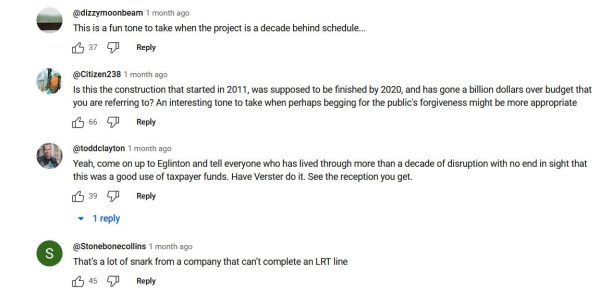I was sitting in the Cineplex at Yonge and Eglinton, watching the pre-show for the new Nic Cage film Dream Scenario. We were still in the ever-expanding advertising portion but not quite into the trailers. Since returning to in-theater movies I’ve noticed the audiences have been sparse, but despite the limited size of the crowd that day I have never experienced a collective emotional outrage quite like what followed. “Go fuck yourself!” someone in the dark shouted. “Condescending assholes!” someone else scoffed. I joined in with the crowd, jeering and groaning as two of the newest Metrolinx ads played.
It’s surprising commercials about transit infrastructure can stir up such a visceral reaction, but to those living in the midtown Yonge and Eglinton area these ads read as a slap to the face. These embarrassing commercials depict the frustrations many Torontonians feel about the ongoing Metrolinx projects as shortsighted, using actors to play average citizens inconvenienced by the noise, construction, and detouring. In the ads — which played back to back — these complaints are pretty mundane, from exasperation that “this Metrolinx construction is killing me” to “Ugh another Metrolinx detour, sooo dumb,” before a condescending friend character speaks up and sarcastically dismisses their concerns. One woman doing yoga replies “All for more transit and fewer cars, helping you breathe cleaner air and live a healthier life? It’s killing you….” These “friends” presumably represent how Metrolinx leadership wishes it could respond to citizens’ complaints directly: by throwing their words back at them with the disingenuous literal contrarianism of a teacher saying “I don’t know, CAN you go to the bathroom?”
This aggressive tone has not always been the case with Metrolinx’s public messaging. This tone shift is best observed by tracing the history of Metrolinx’s apologetic advertising about the LRT and how it evolved into this arrogant new tactic.
The Metrolinx Eglinton LRT project, especially the Yonge-Eglinton station, has become the butt of ten thousand Torontonians’ jokes. Be it the Toronto Star comparing it to world wonders like the Roman Colosseum, Hadrian’s Wall, and the CN Tower (all of which were all completed in shorter timeframes), a local business owner referring to it as a “pit of hell”, or a friend of mine speculating that the massive open holes are to appease the civilization of mole-people living beneath the city, in all cases Torontonians have taken a largely tongue-in-cheek (though characteristically passive-aggressive) attitude to the whole process.
Metrolinx has shown itself to be self-aware about this notoriety, enough so that it began releasing a collection of “It’s Happening” ads in February 2020. Many of these ads analogize the process of Metrolinx development to teens and youth going through the awkward stage of adolescent puberty. Messy rooms and braces stand in for exposed potholes and construction equipment strewn across Toronto’s midtown. Metrolinx thus takes the side of the teenagers who are going through a messy phase but will ultimately grow up to be fine upstanding people (so cut them a little slack dad).
Using analogy in your public messaging can be a fine way to help the public conceptualize the stages of your project. While these self-deprecating ads seemed to position Metrolinx as the struggling young person on the defensive, their attempts to excuse their temporary state revealed the voice that Metrolinx took towards public messaging through innuendo like “sometimes it feels like you’ve been waiting forever to see any progress” or “sometimes things have to look a little worse before they look amazing,” ending with an exasperated “it’s a process!” While initially the ads drew parallels to the awkward phases of puberty, asking for permission to “be a bit awkward” is quite the understatement when it comes to decades-long infrastructure projects. Puberty can’t be helped, and as such Metrolinx’s ads only take a very shallow level of accountability, suggesting that it’s not really their fault that construction looks ugly, or that large projects can cause a mess before they clean up at the end, neither of which are the main concerns of Torontonians, who have seen plenty of construction sites over the years.
Metrolinx switched up its tone in 2021 when it launched the second version of the “It’s Happening” campaign, which takes a much more up-beat approach to its promotion. By focusing attention on the aspirational benefits the completed LRT will provide Torontonians, the ad seems to be much more excited about the future Metrolinx will provide and wants the viewer to get excited as well. It is in this ad, however, that Metrolinx seems to push back directly against the common frustrations of citizens for the first time, opening with the claim that “we’re making more possible for more people” only for a cynical rider to respond “yeah right.” The rest of the ad is dedicated to undermining this “yeah right” by explaining how everyone from dancers, to grandparents, to even those who don’t use transit systems will benefit from its completion, and how we should be excited — even grateful — that we will one day get to ride it. After extracting a concessionary “nice” from the rider the voice over closes by saying “oh come on, it’s more than nice.”
However, it was in their latest campaign, first posted on October 25, 2023, that the tone of Metrolinx ads became explicitly hostile to those levelling their concerns. This hostility is to me the source of Torontonian’s frustrations with the most recent campaign of Metrolinx, which uses the tagline “See beyond the construction.” This campaign was clearly received poorly: it has not been publicly posted to the Metrolinx Youtube account (though I was able to find it unlisted with some digging). Even a cursory scroll of the comments below this video is telling; “That’s a lot of snark from a company that can’t complete an LRT line” writes one commenter; “These are just embarrassingly bad. Kind of like Metrolinx’s track record for finishing projects on time” quips another.

The issue with these ads, which is clearly felt by their supposed audience, lies in the contempt Metrolinx is shown to hold against average Torontonians, portraying them as whiny, entitled, and out of touch urbanites who aren’t being ‘grateful’ enough for the work of Metrolinx, who is so graciously (to the tune of $12.81 billion) constructing key infrastructure. These ads are not an effective way to ingratiate oneself to the Toronto public and leave viewers asking why we would ever trust a company to effectively complete a massive infrastructure job when it seems to hold such contempt for the very people it’s building it for.
Say what you will about the ‘entitlement’ of Torontonians (and I could say a lot), but are Torontonians not entitled to complain about the LRT, its unclear completion schedule, its frequent delays, and the congestion it causes? Are citizens of Toronto not ‘entitled’ to quality infrastructure, progressive urban planning, and a city that they want to live in, and that wants them to live within it?
What confuses me about these ads is that it’s unclear what we the audience are being motivated to feel. Should we feel shame at ourselves for still complaining that the project is incomplete? Does it serve as an attempt to pit us against our fellow citizens who dare complain about a transit project which has for over a decade ironically made transit through midtown Toronto significantly worse? All good advertising includes a ‘call to action’ for its audience to internalize, but if we follow the example of the audience surrogates — the characters making the common complaints — then should we simply … silence our complaints while being lectured to about all the cool stuff that’s right around the corner?
These ads seem to expose a desire by Metrolinx to shut down dialogue, shut up critique, and disregard valid questions that have remained indefinitely unanswered. While the tagline asks us to “see beyond the construction,” the promised benefits of the completed system still remain largely hypothetical. Let’s not forget that currently the system is assumed to be operational as of September 2024, a date picked by the TTC for budgeting purposes and not an official date announced by Metrolinx, which has not promised to achieve the September goal.
While the recently diminishing construction at Yonge and Eglinton has made all four directions of the intersection accessible by foot for the first time in almost a decade, this is only one intersection of a massive, bloated, over-budget, and incomplete public transit project; one that deserves no praise until it is actually completed and providing the service to customers it currently asks them to dream about one day receiving.
Metrolinx spokesperson Andrea Ernesaks has stated “When we have a date we have confidence in, we will share that with the public,” while CEO Phil Verster has promised “once we get through the risks, defects, issues, that we are seeing, finding and fixing, that we will declare a date.” So while we continue business as usual and wait for more updates, I recommend Metrolinx take the opportunity to realize that their next years-long project will be reconstructing the public trust they’ve lost, and rebuilding Torontonian’s confidence in their own competence.
Top image capture from Metrolinx ad.
Craig Meerkamper is a writer from Toronto, a performer, and a graduate of Western University’s Faculty of Information and Media Studies. His work focuses on themes of marketing, propaganda, and the power of analogous storytelling. He can be contacted through his LinkedIn.





4 comments
“…are Torontonians not entitled to complain about the LRT, its unclear completion schedule, its frequent delays, and the congestion it causes?“
Narrowly, only this part, I don’t think they are entitled to complain. They and the decisions and choices they made are responsible for the constructing the Eglinton line the way it’s been built.
We live in a democracy and the electorate needs to take responsibility for the consequences of its actions.
Sadly, the war on pedestrians will go on much longer. Ironic, since the pitch is to get people out of their cars. Somehow that will be achieved by perpetually tearing up and rerouting or blocking sidewalks, leaving trip hazards and terrible way finding signage.
Here’s a head scratchier, after ten years of sidewalk hell, go take a look at the southeast corner of Eglinton and Brownlow, in front of the public school. When they finally remediated that sidewalk, some genius decided it was a good idea to put a fire hydrant right in the middle of it. I wonder what civil engineering or design courses are teaching that as best practice. I’ve already seen people walk into it and being in front of a grade school, I guess the city will have to increase it’s liability insurance to cover kids running into it. But hey, we got lots of money to waste!
The parody ads are spot on: https://storeys.com/toronto-parody-metrolinx-lrt-ad/
Have you ever tried using the GOTrain also powered by the brilliant minds at Metrolinx? Bloor Street GO station for example has No staff on-site to ask questions if you are a tourist or unfamiliar with how it works. And dont try to rely on the advice of fellow GOTrainers because 50% of the time theyre also wrong. If you try to call GO you can go through menu hell based on my experience. There are many machines to swipe your card at every station but God forbid if you mistakenly swipe the wrong machine I.e. UP train or forget to swipe. Who designed this system except someone who obviously doesn’t use transit? Unbelievable.